























Topdek® 700 Roofing
StratcoSKU: Topdek-700-Roofing
Topdek 700 cladding is attached with a concealed clip. This ingenious system provides a clean and strong finish, without any visible fixings. It allows for thermal expansion, making it ideal for long length domestic and industrial roofing. This style of roofing can be ordered to suit your exact requirements. Whether you want to install it yourself or require assistance, we are here to help. Contact us for pricing and further details today.Image gallery


























Concealed Clip Cladding
Innovative, stylish and strong Topdek 700® is an exceptional cladding profile
Utilising an ingenious concealed clip, Topdek® 700 benefits from a strong, clean finish without any visible fixings. It allows for thermal expansion and contraction, making it ideal for long length roofing in both domestic and commercial uses. The profile of Topdek 700 consists of strong, 42mm high, trapezoidal shaped ribs that provide strength and rigidity. Less purlins are needed thanks to the high rib height. Wide deep pans channel water efficiently from the roof making Topdek 700 excellent for areas of high rainfall. Topdek 700 can be installed on roofs with pitches as low as one degree.
Designed to lock together, each Topdek 700 sheet has a male and a female edge that forms a strong locking action when joined together. The anti-capillary shape of the female rib means water is stopped from entering through the side-laps. The sheets lock into the specially designed Topdek 700 clips. The clips are fastened to the purlins with hex head screws (table 8.0) through the holes provided. Although the clips join the roof deck to the purlins, they still allow for expansion and contraction, which is important for long length roofing.
Available Colours:
Brochures & Installation Guides
Topdek 700 Concealed Clip
The most important feature of Topdek 700 is the single piece concealed clip. Its innovative design ensures maximum roofing performance, superior spanning and ease of installation. It is suitable for a variety of industrial and commercial uses, and can be used where a low roof pitch is required and security is important. Buildings such as shopping centres, hospitals, industrial storage, factories and warehouses lend themselves to this style of roofing style because of its strong, reliable, no fuss application.
- Specially designed single piece galvanised steel roof clip eliminates mechanical failure.
- The clip is fastened to the purlin and the roof deck locks onto the clip for a fast and easy installation.
- The secure locking action ensures the deck is water tight and protects against entry.
- All fasteners are covered by the deck helping to minimise fixing corrosion.
- Specially designed recesses for fastening avoid denting the roof sheet.
- Allows for bracket adjustment to accommodate out of square buildings or installer requirements.
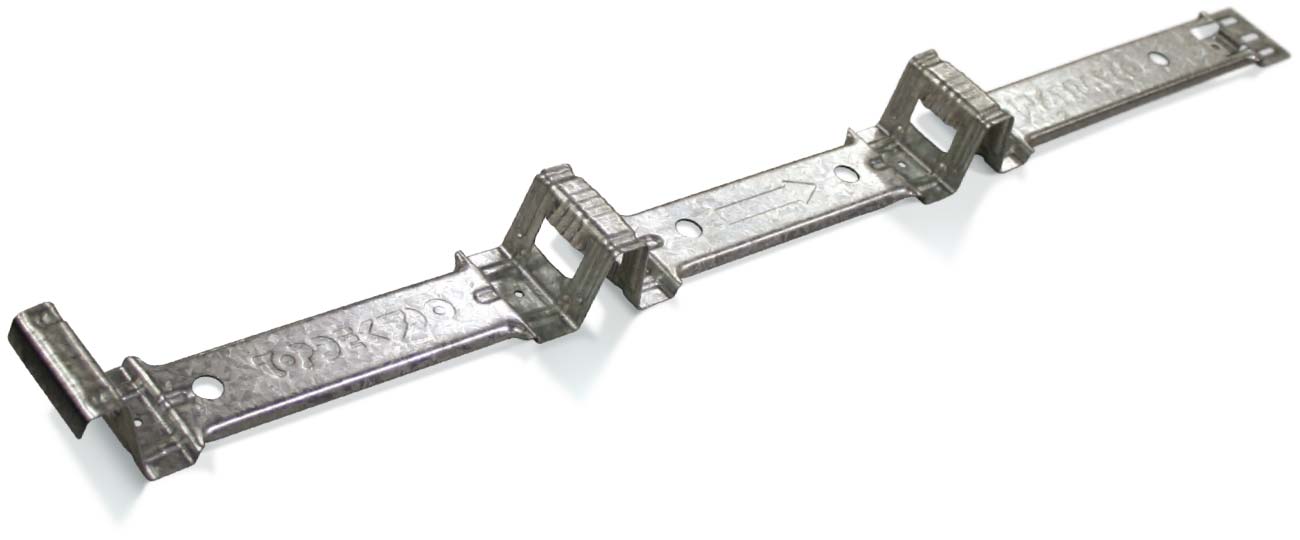
Maintenance Requirements
The performance of Topdek 700 over time depends on its correct application and maintenance. Maintenance should be performed as often as is required to remove any dirt, salt and pollutants. Where used in severely corrosive environments, cleaning should be performed more often. It is important that screws have the same life expectancy as the cladding you have specified.
Packs of Topdek 700 should always be kept dry and stored above ground level while on site. If the sheets have become wet, they should be separated, wiped and placed in the open to dry.
Refer to the Stratco 'Selection, Use and Maintenance' brochure, for more detailed information about the correct use and maintenance of this product.
Custom made for your project
For lengths over 1.2 metres, Topdek 700 can be rolled to the length you require, provided the appropriate transport and handling can be arranged. For lengths longer than ten metres, contact your nearest Stratco for advice on handling and transport. Stratco offer a complete range of flashings and accessories for use with Topdek 700, and can provide professional advice on specific flashings.
Ordering
Sheets are available custom cut, allowing you to minimise waste, and enhance your design options. Topdek 700 is available in un-painted zinc/al, and in an attractive range of factory pre-painted colours. Subject to the delivery location, quantity and material availability, delivery is usually within 48 hours, or at an agreed time that suits your building schedule. Unless advised differently, a one tonne maximum is usually applied to larger packs. Arrangements for unloading the truck are the responsibility of the customer, and should be arranged before ordering. When unloading you must ensure the load is adequately spread. Use spreaders and slings to prevent damage. If packs are to be loaded above structural members, they must be of sufficient strength, such as over portal frames, or braced roof trusses.

Material Specifications
| Material Specifications | |||
| Material Properties | Finish | 0.42 BMT | 0.48 BMT |
|---|---|---|---|
| Total Coated Thickness (TCT) mm | Zinc/al | 0.47 | 0.53 |
| Colour | 0.50 | 0.56 | |
| Mass (kg / linear metre) | Zinc/al | 3.26 | 3.70 |
| Colour | 3.32 | 3.76 | |
| Mass (kg / square metre) | Zinc/al | 4.66 | 5.28 |
| Colour | 4.74 | 5.37 | |
| Yield (square metre / tonne) | Zinc/al | 214.6 | 189.4 |
| Colour | 211.0 | 186.2 | |
| Tensile Strength (MPa) | Zinc/al & Colour | 550 | 550 |
| Width Coverage (mm) | Zinc/al & Colour | 700 | 700 |
| Sheet Tolerances (mm) | Length & Width | ±5 | ±5 |
| Minimum Roof Pitch | Zinc/al & Colour | 1° | 1° |
Design Considerations
The minimum recommended roof pitch for Topdek 700 is one degree (1 in 60). The 700mm coverage of Topdek 700 provides easy handling and installation. Topdek 700 roofing is subject to thermal expansion, particularly on darker colours. The maximum length before an expansion joint is required is 24 metres for lighter colours, and 16 metres for darker colours.
Compliance
The Wind Capacity Tables are based on testing in accordance with AS1562.1-1992 and AS4040.0, 1 & 2- 1992. Span tables have been developed by determining wind pressures in accordance with AS4055-2006 for domestic applications and AS/NZS 1170.2:2002 for all other applications. Capacity tables are in limit state format.
Spans
Spans are determined by wind speeds for non-cyclonic areas. For domestic applications, the pressures and spans are based on a maximum: eaves height of six metres, roof pitch of 35 degrees and total roof height of 8.5 metres. For commercial and industrial applications, tables are based on a maximum overall height of ten metres and a 500 year design return period.
Roofing calculations are based on Cpe=-0.9 and Cpi=0.2, walling is based on Cpe=-0.65 and Cpi=0.2. A local pressure factor, Kl=2.0 has been used for all roofing and walling spans for both strength and serviceability limit states. Roof spans allow for loads incidental to maintenance.

All pressures have been determined assuming the wind loading in any direction is not affected by topography. The following shielding factors have been used for each of the terrain categories: Category 3 = 0.85, Category 2.5 = 0.95, and Category 2 = 1.
The carport and verandah spans only apply to structures not enclosed by peripheral walls. Spans are based on Cpn=-0.9 and Kl=1.5 applied over the entire span, and are suitable for all span types. Loads on supporting purlins may limit these spans.
Stratco can provide additional engineering advice if any design parameters vary from those above.
| Spans (mm) - Three Screws Per Clip | ||||||
| BMT | Application | Span Type | N1 (W28) | N2 (W33) | N3 (W41) | N4 (W50) |
|---|---|---|---|---|---|---|
| 0.42 | Roofing | Single | 2000 | 1750 | 1250 | - |
| End | 2200 | 2100 | 1550 | - | ||
| Internal | 2300 | 2300 | 1650 | - | ||
| Walling | Single | 2850 | 2050 | 1750 | 900 | |
| End | 3000 | 2400 | 1950 | 1350 | ||
| Internal | 3200 | 2900 | 2250 | 1650 | ||
| 0.48 | Roofing | Single | 2200 | 1900 | 1600 | - |
| End | 2950 | 2300 | 2000 | 1300 | ||
| Internal | 3100 | 2850 | 2300 | 1400 | ||
| Walling | Single | 3000 | 2300 | 1900 | 1250 | |
| End | 3250 | 2750 | 2300 | 1800 | ||
| Internal | 3600 | 3250 | 2850 | 2100 | ||
| Spans (mm) - Five Screws Per Clip | ||||||
| BMT | Application | Span Type | N1 (W28) | N2 (W33) | N3 (W41) | N4 (W50) |
|---|---|---|---|---|---|---|
| 0.42 | Roofing | Single | 2000 | 1900 | 1500 | - |
| End | 2200 | 2200 | 1750 | 1300 | ||
| Internal | 2300 | 2300 | 2050 | 1550 | ||
| Walling | Single | 2850 | 2250 | 1900 | 1200 | |
| End | 3200 | 2650 | 2250 | 1850 | ||
| Internal | 3600 | 3100 | 2250 | 2150 | ||
| 0.48 | Roofing | Single | 2200 | 1900 | 1600 | - |
| End | 2950 | 2300 | 2050 | 1550 | ||
| Internal | 3100 | 2950 | 2400 | 2000 | ||
| Walling | Single | 3000 | 2250 | 1900 | 1450 | |
| End | 3600 | 2850 | 2300 | 2050 | ||
| Internal | 3600 | 3350 | 2950 | 2550 | ||
The values are for use with steel supports with a minimum thickness of 0.95mm, G550.
Wind Load Conversion
For domestic applications use the appropriate wind classification for the area. To read the span tables for commercial and industrial applications, select the region and category for the area, then convert it to the correct classification using table 2.0 below.
| Wind Load Conversion | |
| Wind Classification (Domestic) |
Region & Category (Commercial / Industrial) |
|---|---|
| N1 (W28) | Reg A, Cat 3 |
| N2 (W33) | Reg A, Cat 2.5 - Reg B, Cat 3 |
| N3 (W41) | Reg A, Cat 2 - Reg B, Cat 2.5 |
| N4 (W50) | Reg B, Cat 2 |
Maximum Recommended Spans
| Maximum Recommended Spans (mm) | ||||
| Span Type | Roofing (BMT) | Walling (BMT) | ||
|---|---|---|---|---|
| 0.42 mm | 0.48 mm | 0.42 mm | 0.48 mm | |
| Single Span | 2200 | 2200 | 2850 | 3000 |
| End Span | 2200 | 2950 | 3000 | 3250 |
| Internal Span | 2300 | 3100 | 3200 | 3600 |
| Un-stiffened Overhang | 200 | 200 | 300 | 300 |
| Stiffened Overhang | 600 | 600 | 400 | 400 |
Roofing spans are limited, based on typical maintenance foot traffic. Walling spans are based on N1 (W28) wind loading. Spans are based on three fasteners per sheet, per support. The values are for use with steel supports with a minimum thickness of 0.95mm, G550.
Domestic Carport / Patio Spans
| Domestic Carport / Patio Spans (mm) | ||
| Wind Classification | Base Metal Thickness | |
|---|---|---|
| 0.42 mm | 0.48 mm | |
| N1 (W28) | 3800 | 4200 |
| N2 (W33) | 3800 | 4200 |
| N3 (W41) | 2300 | 2600 |
| N4 (W50) | 1500 | 1750 |
Spans are not based on fixing to clips, but on pierce fixing with two fasteners per pan, per support. The values are for use with steel supports with a minimum thickness of 0.95mm, G550.
Wind Capacities
| Wind Capacities (kPa) - Three Fasteners | ||||||||||||
| BMT | Span | Limit State | Span (mm) | |||||||||
|---|---|---|---|---|---|---|---|---|---|---|---|---|
| 900 | 1200 | 1500 | 1800 | 2100 | 2400 | 2700 | 3000 | 3300 | 3600 | |||
| 0.42 | Single | Serviceability | 2.14 | 1.83 | 1.53 | 1.22 | 0.92 | 0.82 | 0.72 | 0.63 | - | - |
| Strength | 3.40 | 3.06 | 2.72 | 2.38 | 2.04 | 1.73 | 1.43 | 1.12 | - | - | ||
| End | Serviceability | 2.47 | 2.19 | 1.90 | 1.62 | 1.33 | 1.05 | 0.87 | 0.70 | 0.53 | 0.35 | |
| Strength | 4.22 | 3.67 | 3.12 | 2.57 | 2.02 | 1.48 | 1.28 | 1.08 | 0.88 | 0.68 | ||
| Internal | Serviceability | 2.13 | 1.94 | 1.76 | 1.57 | 1.39 | 1.20 | 1.05 | 0.90 | 0.75 | 0.60 | |
| Strength | 4.74 | 4.19 | 3.65 | 3.10 | 2.55 | 2.00 | 1.69 | 1.39 | 1.08 | 0.78 | ||
| 0.48 | Single | Serviceability | 2.58 | 2.19 | 1.80 | 1.40 | 1.01 | 0.90 | 0.80 | 0.69 | - | - |
| Strength | 3.68 | 3.43 | 3.17 | 2.91 | 2.65 | 2.45 | 2.24 | 2.04 | - | - | ||
| End | Serviceability | 3.05 | 2.67 | 2.29 | 1.92 | 1.54 | 1.16 | 0.98 | 0.79 | 0.60 | 0.42 | |
| Strength | 5.34 | 4.70 | 4.07 | 3.44 | 2.80 | 2.17 | 1.85 | 1.53 | 1.21 | 0.89 | ||
| Internal | Serviceability | 2.65 | 2.43 | 2.22 | 2.00 | 1.79 | 1.57 | 1.35 | 1.14 | 0.92 | 0.70 | |
| Strength | 5.36 | 4.87 | 4.38 | 3.88 | 3.39 | 2.90 | 2.52 | 2.13 | 1.75 | 1.37 | ||
| Wind Capacities (kPa) - Five Fasteners | ||||||||||||
| BMT | Span | Limit State | Span (mm) | |||||||||
|---|---|---|---|---|---|---|---|---|---|---|---|---|
| 900 | 1200 | 1500 | 1800 | 2100 | 2400 | 2700 | 3000 | 3300 | 3600 | |||
| 0.42 | Single | Serviceability | 2.45 | 2.12 | 1.78 | 1.45 | 1.11 | 0.91 | 0.71 | 0.51 | - | - |
| Strength | 3.73 | 3.38 | 3.02 | 2.67 | 2.32 | 1.91 | 1.51 | 1.11 | - | - | ||
| End | Serviceability | 2.42 | 2.15 | 1.89 | 1.63 | 1.36 | 1.10 | 0.92 | 0.75 | 0.57 | 0.39 | |
| Strength | 5.33 | 4.72 | 4.11 | 3.49 | 2.88 | 2.27 | 2.05 | 1.83 | 1.60 | 1.38 | ||
| Internal | Serviceability | 2.64 | 2.38 | 2.12 | 1.86 | 1.60 | 1.34 | 1.17 | 1.00 | 0.84 | 0.67 | |
| Strength | 5.63 | 5.10 | 4.58 | 4.05 | 3.52 | 2.99 | 2.62 | 2.25 | 1.88 | 1.52 | ||
| 0.48 | Single | Serviceability | 2.60 | 2.20 | 1.79 | 1.39 | 0.98 | 0.88 | 0.78 | 0.67 | - | - |
| Strength | 4.00 | 3.66 | 3.33 | 2.99 | 2.65 | 2.49 | 2.32 | 2.15 | - | - | ||
| End | Serviceability | 3.32 | 2.88 | 2.45 | 2.01 | 1.57 | 1.14 | 1.00 | 0.87 | 0.74 | 0.61 | |
| Strength | 6.12 | 5.40 | 4.68 | 3.95 | 3.23 | 2.51 | 2.26 | 2.01 | 1.76 | 1.51 | ||
| Internal | Serviceability | 3.22 | 2.90 | 2.59 | 2.27 | 1.96 | 1.65 | 1.43 | 1.21 | 0.99 | 0.77 | |
| Strength | 7.23 | 6.50 | 5.78 | 5.05 | 4.32 | 3.59 | 3.14 | 2.69 | 2.23 | 1.78 | ||
The values are for use with steel supports with a minimum thickness of 0.75mm, G550.
Water Carrying Capacity
| Maximum Roof Run For Drainage (m) | ||||||||
| Slope | Peak Rainfall Intensity (mm / hr) | |||||||
|---|---|---|---|---|---|---|---|---|
| 150 | 180 | 200 | 250 | 300 | 350 | 400 | 450 | |
| 1° | 262 | 218 | 196 | 157 | 131 | 112 | 98 | 87 |
| 3° | 454 | 378 | 340 | 272 | 227 | 194 | 170 | 151 |
| 5° | 586 | 488 | 439 | 351 | 293 | 251 | 219 | 195 |
| 7.5° | 719 | 599 | 539 | 431 | 359 | 308 | 269 | 239 |
| 10° | 832 | 693 | 624 | 499 | 416 | 356 | 312 | 277 |
| 15° | 1026 | 855 | 769 | 615 | 513 | 439 | 384 | 342 |
The peak rainfall intensities shown represent a 100 year average recurrence interval (ARI) for a five minute rainfall duration. If roof penetrations exist, the total roof run will generally be greater than the distance from ridge to eaves at the location the penetration interferes with the runoff. Contact Stratco if further advice is required.
Step One
Align the top and bottom clips of the first sheet along the purlins with the arrow pointing in the laying direction, and fasten in positions 1, 2 and 3 (refer to Step 1 below) using the number and type of fasteners specified in the span tables and table 8.0 above. Run a string line between the two clips, or use the edge of the first deck to ensure all clips are in line. Mark the top, bottom and middle purlins at one metre from the starting line and at 700mm centres across the purlins. Use these marks to keep the sheets square.
Align the remainder of the first run of clips to the string line and along the purlins. Fasten in position A, B and C (refer to Step 1 below) using the number and type of fasteners specified.
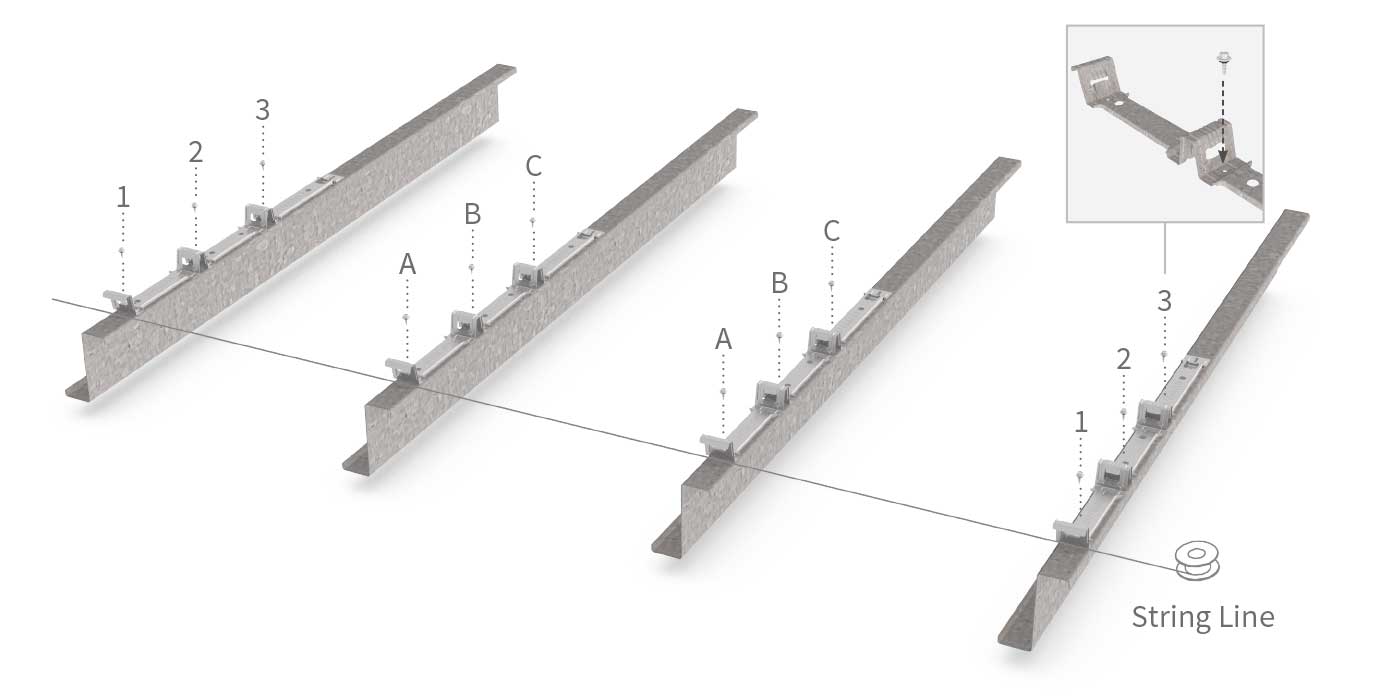
Step Two
Place the first sheet over the clips ensuring a minimum projection of 75mm at the ridge and into the gutter. Snap each rib onto the clip at every purlin using steady foot pressure, ensuring complete deck engagement at every rib on every clip, see the diagram below.
Hook the next run of clips over the last rib of the first sheet. The clips will align themselves and must be butted together for correct positioning. Align the hole with the slot and fasten at the joint first, then work along the bracket. During laying, regularly check the sheets for fanning or creep. If minor adjustment is necessary, the clips can be pulled away from the sheet while fastening.

Step Three
Place the second sheet over the clips, ensure the end of the sheet aligns with the first sheet. Snap the deck onto the clips in the laying order using steady foot pressure and fully engage the interlocking rib onto each clip. It is important to ensure the deck is engaged on each rib, on every clip, and the deck is engaged along its entire length.
Install the remaining clips and sheets. Remember to frequently check the coverage to maintain squareness and adjust for creep where necessary. At the end of the purlin, cut the clips and deck where necessary to suit. To secure the final sheet edge, cut the end off the bracket, hook over the last rib and fasten. Finally, remember to turn up the pans at the ridge and down at the gutter end.
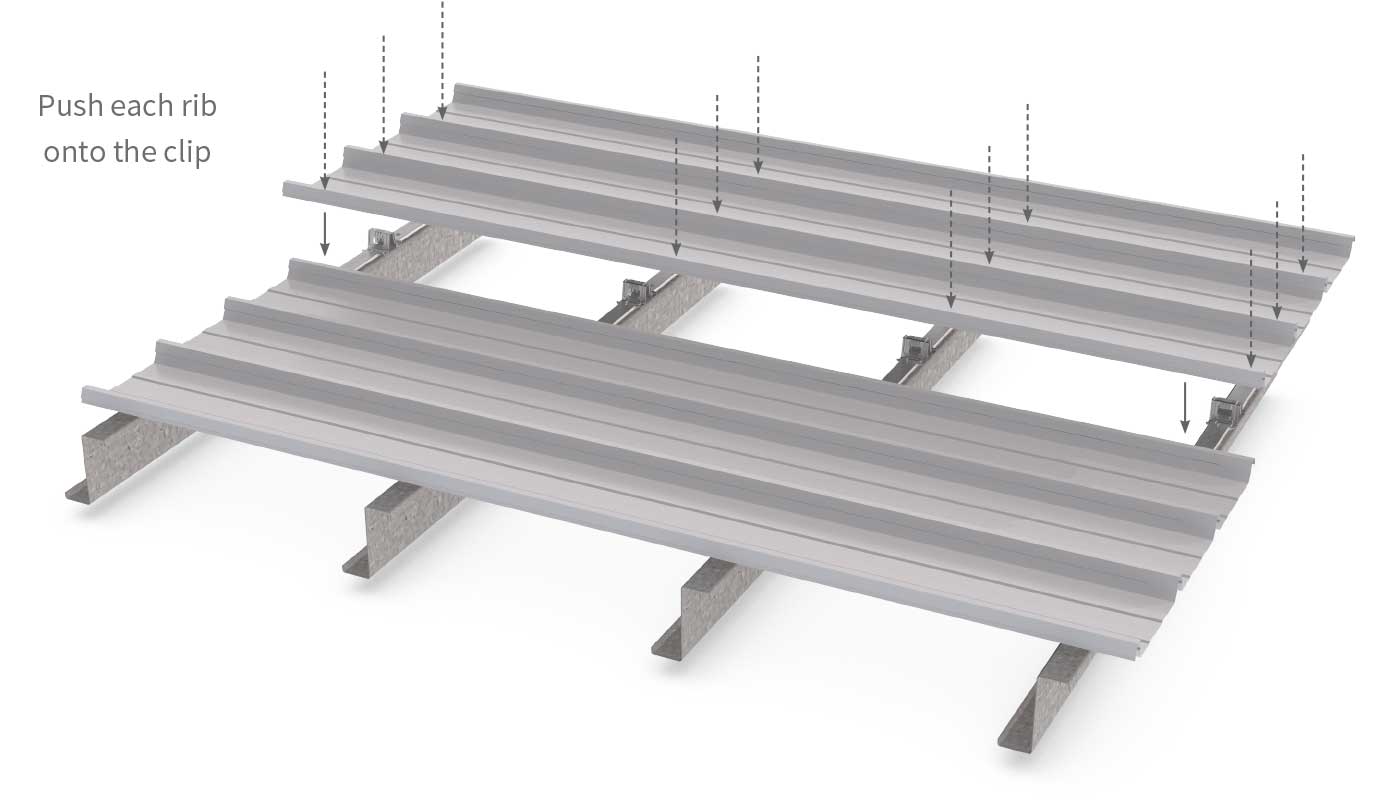
Roof Laying Procedure
Prevailing Wind →
← Laying Direction
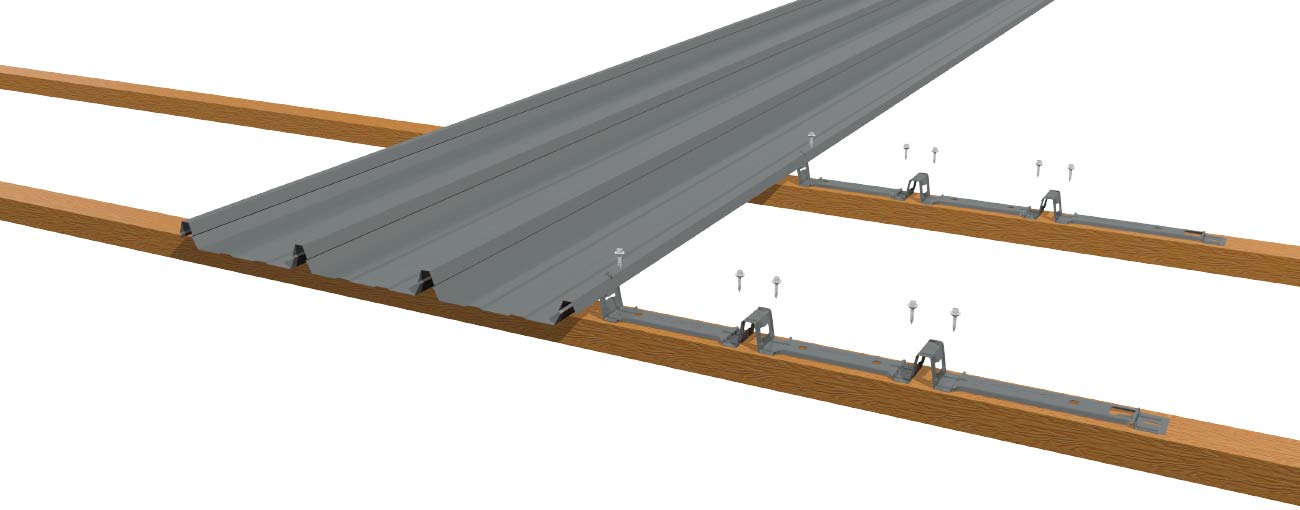
Fastener Selection
Note: The following recommendations apply to non-cyclonic areas.
- All fasteners must comply with Australian standard AS3566.1,2, Class 3.
- In the fastener screw sizes quoted above the first number equals the screw gauge; the second number is the threads per inch and the third number is the screw length.
- Self drilling and tapping screws should not use neoprene washers when securing clips to purlins.
- The minimum number of screws along the clip is three, one at each end and one centrally. For additional strength, five screws may be used.
- the above fastener sizes are suitable for fixing over an insulation blanket up to 55mm thick. For thickness up to 100mm, the next standard screw length to that indicated is to be used.
Fixing to Steel Roofing
Hex Head self drilling screw
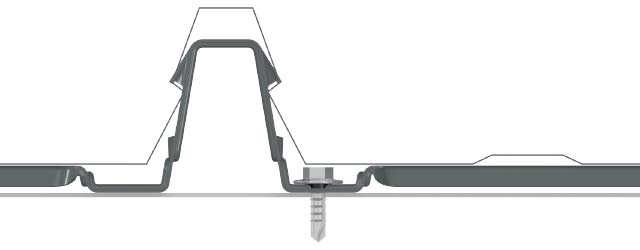
Fixing to Timber Roofing
Type 17 self drilling wood screw

| Fastener Selection for Non-Cyclonic Areas | ||||
| Support | Thickness (mm) | Insulation | Fastener Type | Size (mm) |
|---|---|---|---|---|
| Steel | ≤2.5 | No | Hex head self drilling screw | No.10 - 16x16 |
| Yes | Hex head self drilling screw | No. 10 - 16x25 | ||
| >2.5 ≤ 5.0 | No | Hex head self drilling screw | No. 10 - 24x16 | |
| Yes | Hex head self drilling screw | No.10 - 24x25 | ||
| > 5.0 | No | Drill 4.5mm tapping hole | No.10 - 24x25 | |
| Yes | Drill 4.5mm tapping hole | No.10 - 24x25 | ||
| Timber | >100 | No or Yes | Type 17 self drilling wood screws | No.10 - 12x30 |
Walking on Topdek 700
When walking on Topdek 700 roofing, it is recommended you walk over the purlins to avoid any damage. Wear flat, rubber soled shoes and walk flat footed in the sheet pans only. For carport and verandah applications, use crawl boards to avoid damage during installation and maintenance.
Using Topdek 700
Stratco Topdek 700 will have a long, useful life if used according to Stratco specifications. While roofing materials in outer urban and rural areas may have a life-span in excess of 30 years, this can reduce to only a few years in coastal and industrial environments.
Zinc/al pre-painted steel should not be used in very aggressive areas such as near swimming pools and spas. It is important that dirt, soil, compost, paving sand, or other materials which retain moisture are not placed against steel sheeting. Concrete should not be poured against zinc/al material. Check with Stratco before using in these severe environments.
Incompatible Metals
The best way of reducing corrosion is to keep incompatible metals apart. Zinc/aland pre-painted steel cannot be used with lead, copper and monel. Galvanised steel and pure zinc material can be used with zinc/al, but you must avoid water run-off from zinc/alonto galvanised material. Fixings such as rivets and self-drilling screws must be compatible with the material they are fixing.
Handling and Cutting
For safety, wear gloves when handling Topdek 700. Ensure your hands or gloves are clean, especially when handling zinc/alwhich can mark. Use a coloured pencil for marking steel, as lead or black pencils contain graphite which promotes rusting. Topdek 700 is best cut using tin snips, but for larger cuts it may be necessary to use a power saw with a steel cutting blade or a power nibbler. Avoid using abrasive discs as they can cause burred edges and coating damage. Where possible cut sheets on the ground, and always clean off any swarf and metal filings progressively during the installation. Dispose of off-cuts carefully.
Insulation and Sealants
The use of blanket insulation is recommended in domestic roofing to assist in temperature, condensation and sound control. Topdek 700 can be used with an insulating blanket up to 55mm thick. Increased thicknesses require longer fasteners and greater care when installing.
When choosing a silicone sealant, ensure it is suitable for roofing and guttering use and of a non-acetic, amine free, neutral cure type. Sealants that smell of ammonia, vinegar or lemons are not usually suitable.
